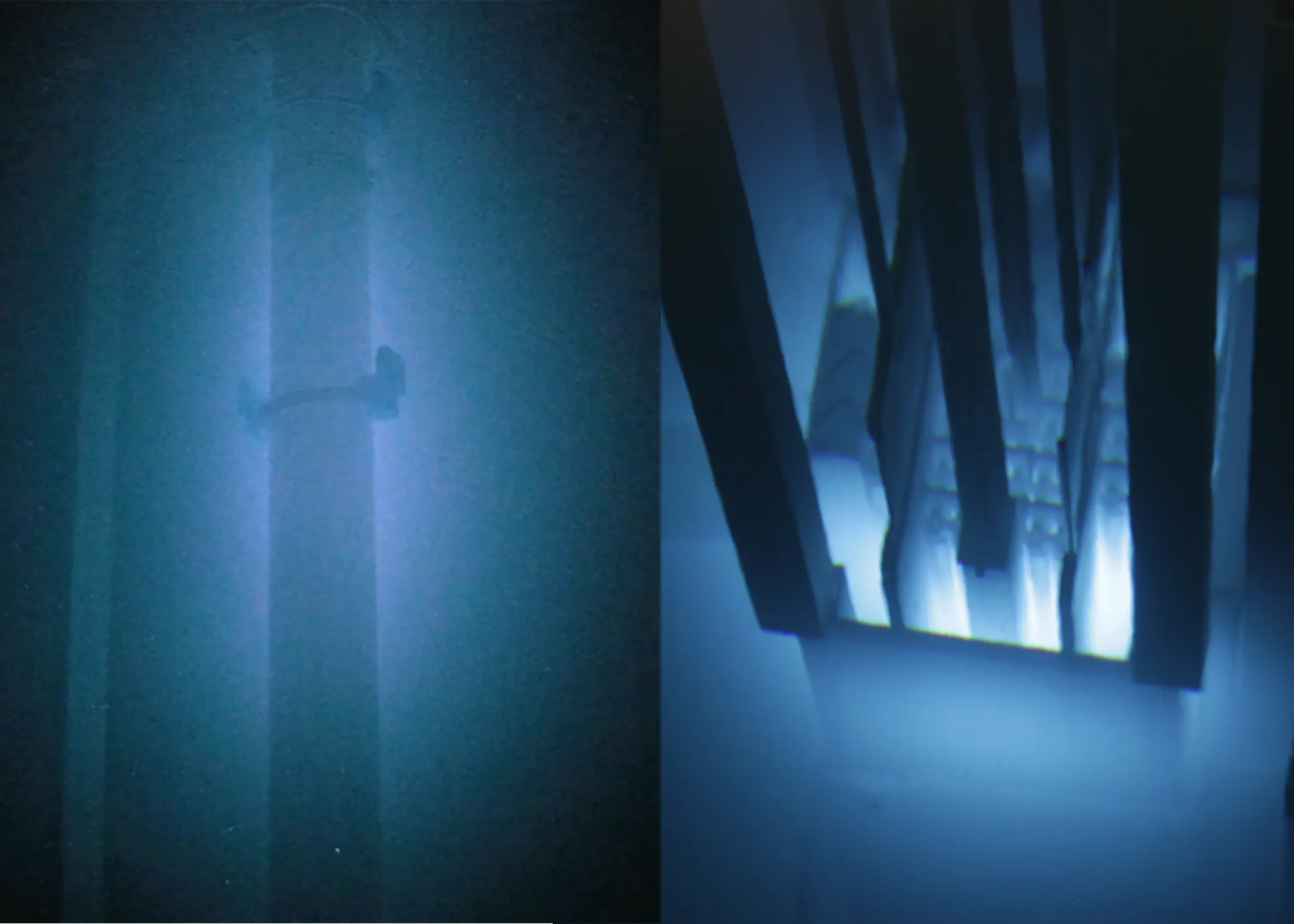SHINE Technologies Achieves Visible Proof of Fusion
By Isaac Clemenger
SHINE technologies announced on 3rd August 2023 that they achieved visible proof of fusion occurring in their device. They observed visible Cherenkov radiation produced by their device.
So, what does this mean, what have they done and why is it important?

Shine Technologies has demonstrated clearly visible Cherenkov radiation (left) produced by fusion © SHINE Technologies
What is Cherenkov radiation?
One of the most fundamental laws of physics is that nothing can travel faster than the speed of light. While this holds true in a vacuum, there are certain circumstances in which this law can be broken. When light travels through a medium it is slowed down. For example, when light travels through water it moves at 75% of the speed of light. This means that particles which move very close to the speed of light can move faster than light in the medium because they are not slowed down by the medium as much as the light is.
If these fast-moving particles are charged, they interact and excite the medium through which they travel, which releases photons (light). As the particle is moving faster than light, the light bunches up behind the particle, interfering in a cone-like shape. So we observe a blue cone emanating from the particle, known as Cherenkov radiation.
This phenomenon is akin to a sonic boom for sound waves.
What have they done?
SHINE has demonstrated clearly visible Cherenkov radiation produced by fusion for what is believed to be the first time in history.
In SHINE’s fusion device, it is believed these fast charged particles are produced when hydrogen absorbs a neutron, releasing a high energy gamma ray. This gamma ray can then collide with an electron, accelerating it to near the speed of light. The target chamber of SHINE’s fusion system is submerged under water, and Cherenkov radiation is observed from the device due to these electrons emitted.
Why is this impressive?
The first observation of Cherenkov radiation dates back to 1910 with Marie Curie, and has been detected in many fission devices. However this is the first ever recorded instance of a fusion device producing Cherenkov radiation.

Marie Curie, who first observed Cherenkov radiation © French Embassy Press Office
Why is this important?
This is a great way of being able to truly visualise fusion happening, and the scale it is happening at too. It adds to the credibility of SHINE’s device and approach to commercialise fusion technology.
“The Cherenkov radiation effect produced here was bright enough to be visible, which means there’s a lot of fusion happening, about 50 trillion fusions per second,” said Gerald Kulcinski, Grainger Professor of Nuclear Engineering-Emeritus and Director of Fusion Technology-Emeritus at the University of Wisconsin-Madison. “These results are … further proof that fusion can produce neutrons on par with some [fission] reactors.”
SHINE intends to use neutrons produced by fusion as a driver to produce both therapeutic and diagnostic medical isotopes, combatting chronic global shortages of critical nuclear medicine that can be used for diagnoses and treatment of heart disease, cancer, and other serious illnesses.
Other than this being a visual demonstration of fusion, there is no practical application of the light.
“Fusion has long captured the imagination of scientists and the public. To be able create visual evidence of fusion is just really cool,” said Greg Piefer, founder and CEO of SHINE. “This visible demonstration of fusion is proof that we are able to produce enough reactivity for some commercial applications historically served by reactors, and clearly demonstrates the next step in our multi-phased approach to ultimately commercialize fusion energy.”
What’s next?
SHINE have outlined a roadmap of four stages: inspecting industrial components; producing medical isotopes; recycling nuclear waste and generating fusion power. Currently they are well under way with Phases 1 and 2, having inspected over 175,000 parts in Phase 1.
For Phase 2, SHINE announced in 2023 that the U.S. Nuclear Regulatory Commission (NRC) issued its final safety report of SHINE’s medical isotope production facility, The Chrysalis.
Research and development have begun on Phase 3, looking into separating spent nuclear fuel so that it can be reused. A similar technology is used in Phase 2, to separate medical isotopes, so in essence this phase has already started in Phase 2. They are also aiming to reduce the nuclear waste stream by attempting to reduce the half lives of waste through transmutation.

Close up view of Cherenkov radiation (left) produced by fusion © SHINE Technologies
Uses of Cherenkov radiation
Cherenkov radiation is widely used in nuclear fission to detect high-energy charged particles. Fission produces high-energy charged particles as the products decay which, when immersed in water, produce Cherenkov radiation.
The International Atomic Energy Agency (IAEA) uses Cherenkov viewing devices which analyse the light given off to verify data reported. This is particularly useful when observing spent nuclear fuel, which is commonly stored in pools underwater. The Cherenkov glow dims as the shorter-lived products decay and the number of charged particles given off reduces.
Fusion approaches tend to use or produce tritium, a radioactive isotope of hydrogen. Tritium does emit charged particles in the form of beta decay (high energy electrons), but these electrons are nowhere near fast enough to produce Cherenkov radiation, so there is no obvious use here it terms of monitoring fuel amounts.
Reuse and recycling of spent nuclear fuel is Phase 3 of SHINE’s roadmap, so there could possibly be some use for Cherenkov radiation there when they reach that stage.
Another common use of Cherenkov radiation is in medical imaging. Cherenkov radiation has recently been used to produce images of radioactive substances in the body. Utilising the Cherenkov radiation, scientists can determine the actual dose and specific location of the radioisotope, which are used in cancer treatments like radiotherapy.
Phase 2 of SHINE’s roadmap is producing isotopes to be used in medical imaging.
